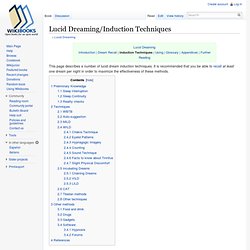

Lucid Dreaming. Lucid Dreaming/Induction Techniques. This page describes a number of lucid dream induction techniques.

It is recommended that you be able to recall at least one dream per night in order to maximize the effectiveness of these methods. Preliminary Knowledge[edit] Certain elements are common to many of the lucidity-inducing techniques discussed later in this chapter. To better understand these techniques, these common components will be discussed first. Sleep Interruption[edit] LUCID DREAMING. How to Lucid Dream. Stephen LaBerge. Stephen LaBerge (born 1947) is a psychophysiologist and a leader in the scientific study of lucid dreaming.

In 1967 he received his Bachelor's Degree in mathematics. He began researching lucid dreaming for his Ph.D. in Psychophysiology at Stanford University, which he received in 1980.[1] He developed techniques to enable himself and other researchers to enter a lucid dream state at will, most notably the MILD technique (mnemonic induction of lucid dreams), which was necessary for many forms of dream experimentation.[2] In 1987, he founded The Lucidity Institute, an organization that promotes research into lucid dreaming, as well as running courses for the general public on how to achieve a lucid dream.[3] His technique of signalling to a collaborator monitoring his EEG with agreed-upon eye movements during REM became the first published, scientifically verified signal from a dreamer's mind to the outside world. Research results[edit]